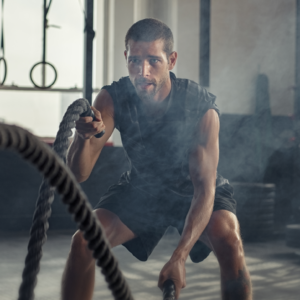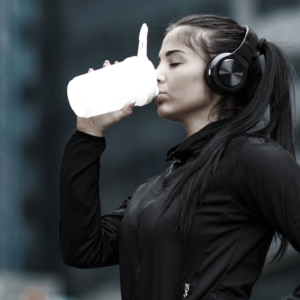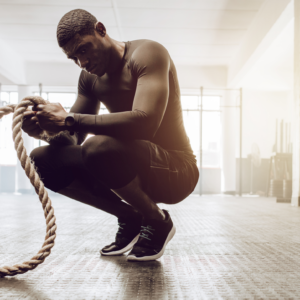- why training breaks are important for your are.
- with which "secret weapons" you can effectively fight your sore muscles. can.
- how you how you can quickly get rid of muscle quickly get rid of.
- What diet for sore muscles is optimal for you.
- what and how much you should drinkto support your muscles.
- which light activities can support the healing process can.
- why a regenerative training can help you can help.
- how to relieve muscle pain in a natural way. can.
- why good sleep supports the healing process for sore muscles.
- which simple acupressure techniques you can use at home.
The cause of sore muscles after your workout
You work out regularly and still you are plagued by aching muscles? Intense physical activity and overuse can cause tiny tears in the muscle fibers. These trigger an inflammatory reaction in the body in which water enters the muscle and causes it to swell. This causes pain and stiffness, which we call muscle soreness. As a rule, the symptoms appear within one to two days after exercise and can last for several days.
Bye-bye sore muscles: 10 effective tips for fast recovery
Have you been "bitten" by sore muscles again? A sore muscle is usually harmless, but you should consult your doctor if your sore muscle lasts longer than 10 days or if you have no explanation for your symptoms.
But you don't have to put up with "normal", harmless muscle soreness. The following effective tips can help you stimulate your body's regeneration processes and alleviate your discomfort:
1. give yourself a break: your muscles will thank you for it
Physical rest and relaxation relax your muscles and can improve the symptoms of your sore muscles. For example, treat yourself to a spa day and enjoy a warming full bath with rosemary, spruce needles or lavender. A visit to the spa or sauna or an intensive peeling to stimulate the blood circulation can also contribute to an effective relief of your sore muscles.
2. hot springs: Heat as a secret weapon against the muscle pain
In the case of severe muscle soreness, some sports physicians advise loosening the muscles with heat from the second day onwards. Whether you use a hot water bottle, a cherry pit cushion, a special ointment or a heat patch - these aids stimulate blood circulation and relax the cramped muscles.
3. foam roller instead of painkillers: this is how you relieve your muscle tension
You don't have to shoot cannons at sparrows when your muscles are sore: instead of taking painkillers, a fascia roller or foam roller can stimulate blood circulation in the skin and muscles and the removal of inflammatory substances, which can relieve your muscle tension. Instead of a fascia roller, you can also use a rolling pin or a water bottle.
When using the fascia roller to treat your sore muscles, you should proceed slowly and gently to avoid injury. Be careful not to roll over your joints. You can watch numerous video tutorials on the web that explain exactly how to use the fascia roller.
4. power food for the muscles: Supply your body with nutrients and proteins
When you exercise, your body excretes fluid and important nutrients such as sodium, calcium, zinc and magnesium through sweating. A balanced diet is therefore crucial for muscle recovery after exercise. The mineral magnesium, which is found in whole grains and dairy products, contributes to normal muscle function and is particularly important for athletes.
If you want to support the muscle regeneration of your body in a natural way, you should eat more carbohydrates in combination with proteins in a 3:1 or 5:1 ratio after a strenuous workout.
Sounds unusual, but it's worth a try: many sports freaks swear by drinking the brine from pickled cucumbers to reduce sore muscles and muscle cramps. The sour taste is said to help curb the activity of nerve cells.
5. why drinking enough is the key against sore muscles
Our muscles consist of up to 80 percent water - similar to the intervertebral disc tissue. If the "bad" muscle soreness has "bitten" you again after an intensive training session, you should drink plenty of water to support the healing of your muscles. We recommend drinking between 2.5 and 3 liters per day. This "water cure" supports you with many minerals and helps your body to flush out toxins and to supply the muscles with sufficient fluid.
If you prefer to drink something with flavor, you can prepare a refreshing fruit spritzer, e.g. with apple or cherry juice - preferably in a 1:1 ratio with mineral water.
6. more movement, less pain: choose your activities carefully
It may sound unusual, but light exercise can help ease the discomfort of sore muscles, such as a nice walk in the fresh air or a yoga session. Moderate exercise stimulates blood circulation, allows important nutrients to be transported to damaged muscles , and supports the healing process so you can get back to your workout soon.
7. cardio with a difference: regenerative training for fast muscle recovery
Exercise and regenerative cardio training are healthy - even if you have sore muscles! However, that doesn't mean you should go all out on the bike, cross trainer or treadmill. Opt for a light restorative cardio workout without a lot of effort to overcome your sore muscles. For example, get on your bike, go for a relaxed jog in the woods or do some yoga exercises.
8. pain relief in a natural way: rubbing the muscles.
Gentle massage-like hand movements and rubbing the affected muscles can help you relieve your sore muscles. Many people use essential oils such as peppermint, eucalyptus or frankincense oil for this purpose. Rubbing alcohol or ointments with arnica are also very popular. Rubbing them in stimulates blood circulation in the muscles and enables better removal of tissue fluid.
9. close your eyes and get through: Good sleep regenerates your muscles
Adequate and good sleep can help you recover your body and muscles. While you sleep, your muscles are loosened and your body releases certain hormones (growth hormones) that can reduce inflammation and aid the healing process.
10. gentle finger pressure against sore muscles: Do you already know these acupressure techniques?
Traditional Chinese Medicine (TCM for short) assumes that the body's self-healing powers are stimulated by activating certain points (trigger points) and can thus contribute to pain relief. However, you don't have to use needles for this as with acupuncture, but can activate the trigger points comfortably with your fingers via acupressure.
You can perform acupressure with your fingertips, thumb, or with assistive devices by rubbing or pressing. Typically, trigger points run along the bones and tendons or are embedded in the muscles. On the Internet or in books on the subject, their location is described in detail. Alternatively, you can locate the trigger points yourself, because they are usually located in a depression and react sensitively to pressure.
How to use acupressure correctly:
- Massage the trigger points gently in a circular motion until the pressure sensitivity decreases after a few seconds or a few minutes.
- You can alternatively hold the trigger points for a few seconds or gently tap them with your fingers (about 20 to 30 times).
We are convinced: With these tips you will quickly get your sore muscles under control again and wish you good luck!
More articles on the topic

BUILD MUSCLE FAST - HOW DO I BUILD MASS FAST AS A HARDGAINER?
If you are one of those body types who find it very difficult to build muscle mass, then this article here is for you. Because here

WHAT REALLY HELPS AGAINST SORE MUSCLES?
How nice it would be to be able to build new muscle mass without having to endure the annoying muscle soreness. To constantly set new stimuli, to try out different training variants,

MUSCLE MEMORY - QUICKLY REBUILD LOST MUSCLE MASS
You were in shape, regularly in the gym and gained some muscle mass - but then it came: the unwanted training break. Caused by
